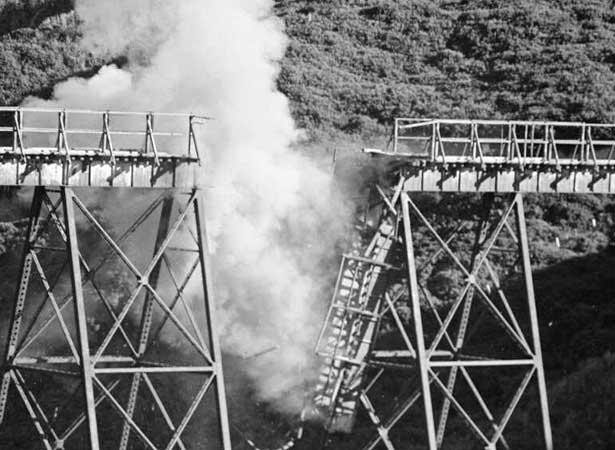
The towering Belmont railway viaduct was built in 1885 by the Wellington and Manawatu Railway Company (WMR) to bridge a deep gully at Pāpārangi, north-east of Johnsonville, Wellington. Unused since 1937, when the Tawa Flat deviation was opened, it was demolished by Territorial Force engineers.
The original wooden viaduct formed part of the WMR line between Wellington and Longburn, near Palmerston North, which was completed in November 1886. Standing 38 m high and 104 m long, this was the largest wooden trestle bridge in New Zealand, and one of the largest in the world at the time. Its construction required 212,000 superficial feet of kauri timber.
In 1903 (in part because of concerns over the fire risk) it was replaced by a steel viaduct, which was built around the wooden structure without requiring any closures of the line. In 1908, when the WMR was bought by the government, its line – including the Belmont viaduct – became part of the newly completed North Island Main Trunk Line.
By the 1920s, the steep, twisting line between Wellington and Johnsonville was unable to handle the demands of main trunk traffic. Work on the Tawa Flat deviation out of Wellington, which included two long tunnels passing under Cashmere, Newlands, Pāpārangi and Grenada, began in 1927; this opened to freight traffic in 1935 and to passenger trains in June 1937. The old WMR line was then cut off at Johnsonville and became a suburban commuter line, operated from July 1938 by New Zealand’s first electric multiple units.
The Belmont viaduct was left to rust for 14 years. In October 1951, with concerns about public safety, it was decided to demolish the now-derelict structure. Territorial Force engineers were given the job as a training exercise. On 15 December, the 66-year-old viaduct was destroyed by 44 kg of TNT. Its original concrete abutments can still be seen in the regenerating bush of Seton Nossiter Park.
Read more on NZHistory
Belmont railway viaduct – The North Island main trunk lineBlowing up Belmont railway viaduct – The North Island main trunk line
External links
How to cite this page
'Belmont viaduct blown up', URL: https://nzhistory.govt.nz/page/belmont-viaduct-blown, (Ministry for Culture and Heritage), updated 15-Dec-2021
